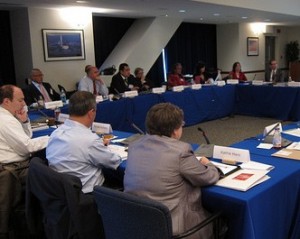Key Updates from the Fall 2011 PACHA Meeting
Topics

The Presidential Advisory Council on HIV/AIDS (PACHA) convened for a meeting on September 29 and 30, 2011, in Washington, DC. The Council heard from both members of PACHA subcommittees and external presenters. Highlights of some of those sessions include:White House UpdateMr. Jeffrey Crowley, Director of the Office of National AIDS Policy (ONAP), opened the meeting with a brief update on a range of activities including the National HIV/AIDS Strategy (NHAS) Implementation Dialogues, a series of conversations in five cities across the country that recently commenced in Birmingham, Alabama. These dialogues serve as a forum for communities and sectors to discuss issues related to the implementation of the strategy. He thanked the PACHA members who are assisting ONAP with the upcoming Implementation Dialogues in Philadelphia, Seattle, Baton Rouge, and Des Moines, and encouraged members to attend when possible. Mr. Crowley also shared that his office was working on the Fiscal Year (FY) 2012 Federal budget, including the proposed Strategy Implementation Fund, as well as the FY 2013 budget. Finally, he acknowledged the Council’s recent letter to the President (PDF 237KB), containing several recommendations to help reach the Strategy’s goals and shared that a response from the White House was being developed.
CDC FOAThe Council was briefed on the Center for Disease Control and Prevention’s recent funding opportunity announcement (FOA) for funding opportunity announcement (FOA) for HIV prevention programs for health departments (NASTAD), shared some concerns that her members have about the revisions reflected in the FOA and their potential impact on future HIV prevention efforts across the Nation. These include the fact that NASTAD believes HIV prevention has been and continues to be “woefully underfunded,” reflecting only four percent of Federal domestic HIV investments. NASTAD urged examination of whether all other Federal domestic HIV resources are being used to better purpose than prevention. She noted that a number of State health departments will experience substantial reductions in the levels of funding they receive for HIV prevention activities under this new funding opportunity. This is cause for concern among many States, particularly those with relatively low HIV incidence since the reductions will impair their ability to maintain the HIV prevention infrastructure that they have developed over the years. In addition, Ms. Scofield urged restoration of funding that has been reduced to the pool of resources available to the health departments.
HHS Metrics Workgroup UpdateDr. Andrew Forsyth, Senior Science Advisor in the Office of HIV/AIDS Policy, updated the Council on efforts underway in the Department of Health and Human Services to streamline and standardize HIV program metrics and data collection activities in response to the Strategy’s call for a more coordinated national response to the epidemic. He highlighted efforts of an internal working group to inventory the various measures in use as well as a recent consultation with external stakeholders including representatives from State and local health departments, community-based organizations, academia, and others. He noted that the Department’s work with the jurisdictions participating in the 12 Cities Project has been very helpful in informing this process.
Youth and HIVA year after last examining the issue of youth and HIV, PACHA devoted a half-day of the meeting to a series of presentations on the topic by representatives of key Federal agencies, providers of youth services, and youth leaders. The presentations underscored the unique challenges youth face and showcased several innovative responses to youth HIV/AIDS prevention, care, and treatment. Miguel Gomez of HIV.gov discussed trends in the use of mobile technology by youth and how this can be an effective instrument to reach young people. Ms. Deborah von Zinkernagel shared how PEPFAR uses new media to reach youth through their HIV Free Generation video game and the SHUGA online drama series. Dr. John Douglas of CDC discussed how the Division of Adolescent and School Health (DASH) targets its investments primarily for State and local education agencies and non-governmental organizations to improve classroom education and promote model school policy. Ms. Evelyn Kappler, Acting Director of the newly formed HHS Office of Adolescent Health, profiled how HIV prevention is integrated into a number of its pregnancy prevention grant programs. Finally, the Council heard from two compelling young leaders who shared personal perspectives. Mr. Lawrence Stallworth of Ohio Advocates Youth Leadership Council spoke about his life after receiving an HIV diagnosis and the discrimination and stigma he has experienced. Ms. Sade Powell, an HIV peer educator representing the International Youth Leadership Council, shared that among the young people she engages with she finds not only a lack of HIV awareness, but also only marginal interest in learning about or adopting behaviors that decrease risk of contracting HIV.
The presentations and rich discussions that followed each provided the members of the PACHA with much to consider as they continue their work in the months ahead.